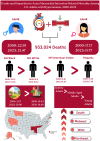Trends and Disparities in Acute Myocardial Infarction-Related Mortality Among U.S. Adults With Hypertension, 2000-2023
- PMID: 40259707
- PMCID: PMC12012249
- DOI: 10.1002/clc.70129
Trends and Disparities in Acute Myocardial Infarction-Related Mortality Among U.S. Adults With Hypertension, 2000-2023
Abstract
Background: Hypertension is a major public health concern and a key risk factor for acute myocardial infarction (AMI), significantly contributing to cardiovascular mortality. Despite advancements in management and treatment, trends in associated mortality remain underexplored.
Objective: This study examines U.S. national trends in hypertension- and AMI-associated mortality from 2000 to 2023, focusing on demographics and regions.
Methods: Age-adjusted mortality rates (AAMRs) per 100,000 for adults aged ≥ 25 with hypertension and AMI were extracted from the CDC WONDER database. Annual percent changes (APCs) and average APCs (AAPCs) with 95% confidence intervals (CIs) were calculated, stratified by year, sex, race/ethnicity, age, urbanization, and Census region.
Results: From 2000 to 2023, 933,024 hypertension- and AMI-related deaths were recorded. Overall, AAMR declined from 19.84 per 100,000 in 2000 to 16.26 in 2023 (AAPC: -0.93%, 95% CI: -1.18% to -0.76%). However, a sharp rise in mortality occurred between 2018 and 2021, coinciding with the COVID-19 pandemic. Stratified analyses revealed persistently higher mortality rates among menmen, non-Hispanic BlackBlack individuals, and residents of the Southern and rural U.S. regions. Younger adults showed an increasing AAMR trend, indicating a growing burden of hypertension and AMI-associated disease.
Conclusion: While long-term mortality trends show a decline, recent years have seen a rise, particularly among high-risk groups. Targeted public health interventions addressing hypertension management, cardiovascular risk reduction, and healthcare disparities are essential to mitigate the ongoing burden of hypertension and AMI mortality in the U.S.
Keywords: CDC WONDER database; acute myocardial infarction; cardiovascular diseases; census region; gender; healthcare disparities; hypertension; mortality trends; race; urbanization.
© 2025 The Author(s). Clinical Cardiology published by Wiley Periodicals, LLC.
Conflict of interest statement
The authors declare no conflicts of interest.
Figures




References
-
- Cardiovascular Diseases Affect Nearly Half of American Adults, Statistics Show. www.heart.org, accessed February 10, 2025, https://www.heart.org/en/news/2019/01/31/cardiovascular-diseases-affect-....
-
- CDC . Hypertension Prevalence in the U.S. | Million Hearts®. Centers for Disease Control and Prevention. May 12, 2023, accessed February 10, 2025, https://millionhearts.hhs.gov/data-reports/hypertension-prevalence.html.
-
- CDC . Federal Hypertension Leadership Council (The Council). High Blood Pressure. January 16, 2025, accessed February 10, 2025, https://www.cdc.gov/high-blood-pressure/php/fhclc/index.html.
-
- Mechanic O. J., Gavin M., and Grossman S. A., Acute Myocardial Infarction (StatPearls. StatPearls Publishing, 2025), accessed February 10, 2025. http://www.ncbi.nlm.nih.gov/books/NBK459269/. - PubMed
Publication types
MeSH terms
Grants and funding
LinkOut - more resources
Full Text Sources
Medical
Miscellaneous

